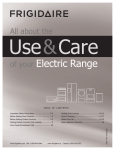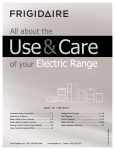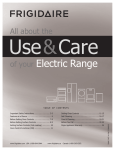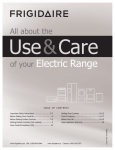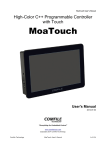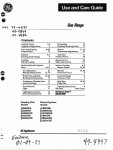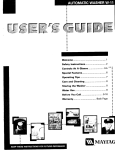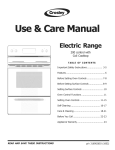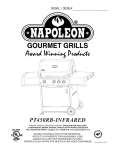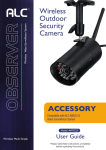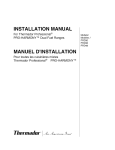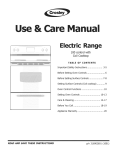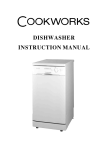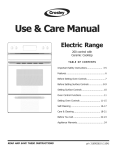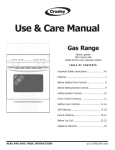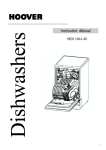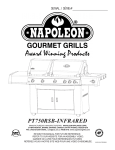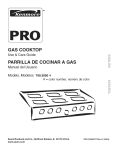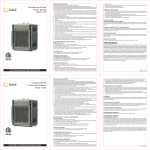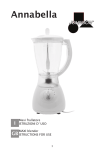Download ut the
Transcript
ut the f your Electric Range TABLE Important Safety Instructions ........................... OF Setting Oven Controls .................................. 12-15 6 Self-Cleaning .............................................. 16-17 Before Setting Oven Controls ........................... 7-8 Care & Cleaning .......................................... 18-21 Before Setting Surface Controls ....................... 8-9 Before You Call ............................................ 22-23 Appliance Features ........................................... 3-5 CONTENTS Setting Surface Controls (Coil cooktop) .............. 10 Oven Control Functions (200) ............................ 11 Warranty ............................................. 316902215 back page (Sep 2009) Table of contents Serial plate location and product record .......................... 2 Important Safety Instructions ............................ 3-5 Appliance Features ................................................ 6 Before Setting Oven Controls ............................... 7-8 Oven vent location ..................................................... 7 Removing, replacing & arranging the oven racks ........... 7 Before Setting Surface Controls ........................... 8-9 Cookware material types ............................................ 9 Element ON indicator light(s) ...................................... 9 Home Canning .......................................................... 9 Setting Surface Controls ....................................... 10 Oven Control Functions ......................................... 11 Setting Oven Controls ...................................... 12-15 Setting the clock ...................................................... 12 Changing between continuous bake or 12-Hour Energy Saving features ............................................ 12 Changing oven temperature display (F° or C°) ............ 12 Timer ................................................................. 12-13 Setting oven lockout ................................................. 13 Setting bake ........................................................... 13 Setting broil ............................................................ 14 Adjusting oven temperature ..................................... 15 Operating interior oven light ..................................... 15 Self-Cleaning .................................................... 16-17 Care &Cleaning ............................................... 18-21 Surface elements and drip bowls .............................. 19 Replacing the oven light ........................................... 20 Removing & replacing oven door ............................... 21 Before You Call This Use & Care Guide is part of our commitment to customer satisfaction and product quality throughout the service life of your new appliance.We view your purchase as the beginning of a relationship. To ensure our ability to continue serving you, please use this page to record important product information. Need help?? Before you call for service, there are a few things you can do to help us serve your better. Read this Use & Care. It contains instructions to help you use and maintain your range properly. If you received a damaged range ... immediately contact the dealer (or builder) that sold you the range. Save time and money. Check the section titled "Before you call". This section helps step you through some common problems that might occur. Serial plate location Solutions to common problems ............................. 22-23 Warranty .................................................. back page open storage drawer (some models) or remove lower front panel (some models). Record model & serial numbers here Purchase date Model number Serial number Read all instructions before Do not attempt to install or operate your appliance until you have read the safety precautions in this manual. Safety items throughout this manual are labeled with a WARNING or CAUTION statement based on the risk type. using this appliance. Ask your dealer to recommend a qualified technician and an authorized repair service. Know how to disconnect the power to the range at the circuit breaker or fuse box in case of an emergency. Definitions IlL This is the safety alert symbol. It is used to alert you to potential personal injury hazards. Obey all safety messages that follow this symbol to avoid possible injury or death. • All ranges can tip. • Injuryto persons could result. • Install anti-tipdevice packed with range. • See Installation Instructions. WARNING indicates a potentially hazardous situation which, if not avoided, may result in death To reduce the risk of tipping, the range must be secured by properly ........... °r seri°us inJuw: ................................................................................................................................................................................................... installed a nti-ti p bracket provided with the range. To check if the bracket is installed properly, visually check that rear leveling leg is CAUTION indicates a potentially hazardous inserted into and fully secured by the anti-tip bracket by removing lower situation which, if not avoided, may result in minor front panel or storage drawer from or moderate injury. the range. IMPORTANT indicates installation, operation, maintenance or valuable information that is not hazard For models equipped with a warmer drawer or lower oven, grasp the top rear edge of the range and carefully attempt to tilt it forward. Refer to the installation instructions for proper anti- tip bracket installation. related. Important Safety Instructions • Remove all tape and packaging before using the range. Destroy the carton and plastic bags after unpacking the range. Never allow children to play with packaging material. • Proper installation--Be sure your appliance is properly installed and grounded bya qualified technician in accordance with the National Electrical CodeANSI/N FPA No. 70 latest edition and local electrical code requirements. Install only per installation instructions provided in the literature package for this range. • User servicing--Do not repair or replace any part of the appliance unless specifically recommended in the manuals. All other servicing should be done only by a qualified technician. This may reduce the risk of personal injury and damage to the range. Save these instructions Never modify or alter the construction of a range by removing the leveling legs, panels, wire covers, anti-tip brackets/screws, or any other part of the range. • Remove the oven door from any unused range if it is to be stored or discarded. Stepping, leaning or sitting on the door or drawers of a range can result in serious injuries and also cause damage to the appliance. DO NOT allow children to climb or play around the range. The weight of a child on an open oven door may cause the range to tip, resulting in serious burns or other injury. Never use your appliance for warming the room. Do not use the oven, warmer drawer oven (if equipped) for storage. for future reference. or heating or lower • Storage in or on appliance--flammable materials should not be stored in an oven, warmer drawer, near surface units or in the storage drawer. This includes paper, plastic and cloth items, such as cookbooks, plasticware and towels, as well as flammable liquids. Do not store explosives, such as aerosol cans, on or near the range. • DO NOT LEAVE CHILDREN ALONE--children should not be left alone or unattended in the area where appliance is in use, They should never be allowed to sit or stand on any part of the appliance, including the storage drawer, lower broiler drawer, warmer drawer or lower double oven. • Do not use water or flour on grease fires-smother the fire with a pan lid, or use baking soda, a dry chemical or foam-type extinguisher. • When heating fat or grease, watch it closely. Fat or grease may catch fire if allowed to become too hot. Use dry potholders - moist or damp potholders on hot surfaces may result in burns from steam. Do not let potholders touch hot heating elements. Do not use a towel or other bulky cloth instead of a potholder. • Do not heat unopened food containers - buildup of pressure may cause container to burst and result in injury. IMPORTANT YOUR OVEN • Do not store items of interest to children in the cabinets above a range or on the backguard of the range. Children climbing on the range to reach items could be seriously injured. • Do not touch surface heating units or surface cooking elements, areas near these units or elements, or interior surface of the oven. Both surface heating and oven heating elements may be hot even though they are dark in color. Areas near surface cooking units may become hot enough to cause burns. During and after use, do not touch, or let clothing or other flammable materials touch these areas until they have had sufficient time to cool. Among these areas are the cook top, surfaces facing the cook top, the oven vent openings and surfaces near these openings, oven door and oven door window. • Wear proper apparel--loose-fitting or hanging garments should never be worn while using the appliance. Do not let clothing or other flammable materials contact hot surfaces. Do not attempt to operate the range during a power failure. If the power fails, always turn off the range. If the range is not turned off and the power resumes, the range will begin to operate again. Once the power resumes, reset the clock and oven function. INSTRUCTIONS FOR USING • Use care when opening oven door, lower oven door or warmer drawer (if equipped)--Stand to the side of the range when opening the door of a hot oven. Let hot air or steam escape before you remove or replace food in the oven. Keep oven vent ducts unobstructed. The oven vent is located under the left rear surface element if your model is equipped with coil elements. The oven vent is located below the backguard for models equipped with ceramic-glass cook tops. Touching the surfaces in this area when the oven is operating may cause severe burns. Also, do not place plastic or heat-sensitive items on or near the oven vent. These items could melt or ignite. Placement of interior oven racks. Always place oven racks in desired location while oven is cool. If rack must be moved while oven is hot use extreme caution. Use potholders and grasp the rack with both hands to reposition. Do not let potholders contact the hot heating elements in the oven. Remove all utensils from the rack before moving. Do not use the broiler pan without its insert. The broiler pan and its insert allow dripping fat to drain and be kept away from the high heat of the broiler. Do not cover the broiler insert with aluminum foil. Exposed fat and grease could ignite. Protective liners--Do not use aluminum foil to line the oven bottom. Only use aluminum foil as recommended in this manual. Improper installation of these liners may result in risk of electric shock, or fire. SELF-CLEANING OVENS IMPORTANT • Clean in the self-cleaning cycle only the parts listed in this Use &Care Manual. Before self-cleaning the oven, remove the broiler pan and any utensils or foods from the oven. • Do Not Use Oven Cleaners--No commercial oven cleaner or oven liner protective coating of any kind should be used in or around any part of the oven. • Do Not Clean Door Gasket--The door gasket is essential for a good seal. Care should be taken not to rub, damage or move the gasket. • The health of some birds is extremely sensitive to the fumes given off during the self-cleaning cycle of any range. Move birds to another well-ventilated room. IMPORTANTINSTRUCTIONS YOUR FOR CLEANING RANGE • Clean the range regularly to keep all parts free of grease that could catch fire. Pay particular attention to the area around each surface element. Do not allow grease to accumulate. • Kitchen cleaners and aerosols--Always follow the manufacturer's recommended directions for use. Be aware that excess residue from cleaners and aerosols may ignite causing damage and injury. • Clean ventilating hoods frequently--Grease should not be allowed to accumulate on the hood or filter. Follow the manufacturer's COIL COOK TOP instructions for cleaning hoods. MODELS • Make Sure Reflector Pans or Drip BowlsAre in Place-Absence of these pans or bowls during cooking may subject wiring or components underneath to damage. • Protective Liners--Do not use aluminum foil to line surface unit drip bowls, or reflector pans. Only use aluminum foil as recommended in this manual. Improper installation of these liners may result in risk of electric shock, or fire. YOUR INSTRUCTIONS FOR USING COOKTOP • Know which knob controls each surface heating unit. Place a pan of food on the unit before turning it on, and turn the unit off before removing the pan. Use proper pan size--This appliance is equipped with one or more surface units of different sizes. Select utensils having flat bottoms large enough to cover the surface unit heating element. The use of undersized utensils will expose a portion of the heating element to direct contact and may result in ignition of clothing. Proper relationship of utensil to element will also improve efficiency. Utensil handles should be turned inward and not extend over adjacent surface elements--To reduce the risk of burns, ignition of flammable materials, and spillage due to unintentional contact with the utensil, the handle of the utensil should be positioned so that it is turned inward, and does not extend over adjacent surface units. Never leave surface elements unattended at high heat settings--Boilovers cause smoking and greasy spillovers that may ignite, or a pan that has boiled dry may melt. Do not immerse or soak removable heating elements--Heating elements should never be immersed in water. Heating elements clean themselves during normal operation. Glazed cooking utensils--Only certain types of glass, glass/ceramic, ceramic, earthenware, or other glazed utensils are suitable for cook top service without breaking due to the sudden change in temperature. Check the manufacturer's recommendations for cook top use. When flaming foods under a ventilating the fan on. IMPORTANT SAFETY hood, turn NOTICE The California Safe Drinking Water and Toxic Enforcement Act requires the Governor of California to publish a list of substances known to the state to cause cancer, birth defects or other reproductive harm, and requires businesses to warn customers of potential exposure to such substances. 0 0 Eleme_t OFF OFF Io Or_ 0 OFF OFF h_ s,m 2 8 3 7 2 8 3 7 o + +0 reed reed O0 eo QO oo Your electric 1. 2. 3. 4. 5. 6. 7. 8. 9. 10. 11. 12. 13. 14. 15. 16. 17. 18. 19. 20. 21. 22. range 2 sm 2 ,o 3 \ ' Gibson features 8 8 7 0 ++ +++0 00 oo O0 oe include: Electronic oven control with kitchen timer. Left front single element control. Left rear single element control. Right rear single element control. Right front single element control. ElementOnindicatorlight(s). Oven interior light switch. Oven interior light with removable cover (some models). Automatic oven door light switch (some models). Self-cleaning oven interior. Self-clean door latch. Adjustable interior oven rack(s). Large 1-piece oven door handle. Full width oven door (styles vary by model). Storage drawer with integrated handle (some models) or cover panel (some models). Easy to clean upswept coil element cooktop. 6"single element(s). 8"single element(s). Removable element drip bowls (some models). Broil pan (some models). Broil pan insert (some models). Leveling legs and anti-tip bracket (included). The features shown for your appliance may vary according to model type & color. O +!!!!!!!!!!!!!!!!!!!!!!!!!!!!!!!!!!!!!!!!!!!!!!!!!!!!!!!!!!!!!!!!!!!!!!!!!!!!!!!!!!!!!!!!!!!!!!!!!!!!!!!!!!!!!!!!!!!!!!!!!!!!!!!!!!!!!!!!!!!!!!!!!!!!!!!!!!!!!!!!!!!!!!!!!!!!!!!!!!!!!!!!!!!!!!!!!!!!!!!!!!!!!!!!!!!!!!!!!!!!!!!!!!!!!!!!!!!!!!!!!!!!!!!!!!!!!!!!!!!!!!!!!!!!!!!!!!!!!!!!!!!!!!!!!!!!!!!!!!!!!!! Oven vent location The oven vent is located under the left rear surface element (See Fig. 1). When the oven is on, warm air passes through the vent. This venting is necessary for proper air circulation in the oven and good baking results. Do not block the oven vent. Types of oven racks Your range may be equipped with one or more of the following oven rack styles shown. flat handle oven rack fiat oven rack Fig. 1 offset oven rack Always use oven mitts when using the oven. When using the appliance, the oven, oven racks and cooktop will become VERY HOT which can cause burns. Removing, racks replacing & arranging oven To remove - pull the rack forward until it stops. Lift up front of rack and slide out. To replace - fit the rack onto the guides on the oven walls. Tilt the front of the rack upward and slide the rack back into place. Arranging - always arrange the oven racks when the oven is cool (prior to operating the oven). bottom oven rack The flat oven rack (some models) or flat handle oven rack (some models) may be used for most cooking needs. The offset oven rack (some models) is designed to place the base of the rack about 1/2 of a rack position lower than normal. This rack design provides several additional possible positions between the standard postions. To maximize oven cooking space place the bottom oven rack (some models) in the lowest rack position for baking and when roasting large cuts of meat. Recommended rack positions Food type by food type Position (See Fig. 2) Broiling meats Cookies, cakes, pies, biscuits & muffins Frozen pies, angel food cake, yeast, bread, casseroles Small cuts of meat or poultry Turkey, roast or ham Fig. 2 See broil section 3or4 2or3 2or3 2 Air circulation in the oven Baking For best baking results allow 2-4" (5-10 cm) around the cookware for proper air circulation and be sure pans and cookware do not touch each other, the oven door, sides or back of the oven cavity. Hot air must be able to circulate around the pans and cookware in the oven for even heat to reach around the food. layer cakes proper 1 or 2 oven racks Fig. 2 Fig. 1 Using with For best results when baking cakes using 2 flat oven racks, place cookware on rack positions 2 & 5 (See Fig. 1). For best results when using a single oven flat rack, place cookware on rack positions 2, 3 or 4 (See Fig. 2). cookware The size and type of cookware used will influence the setting needed for best cooking results. Be sure to follow the recommendations for using proper cookware as illustrated in Figs. 3 & 4. Cookware should have flat bottoms that make good contact with the entire surface heating element. Check for flatness by rotating a ruler across the bottom of the cookware (See Fig. 3). \ _ii_iii'ii_i_ii'ii_i_ii'i_iii_ii!_!_i • Curved and warped pan • Flat bottom sides. and bottoms. straight • Tight fitting lids. • Weight of handle does not tilt cookware. Cookware is well balanced. • Cookware size matches the amount of food to be prepared and the size of the surface element. • Made of material that conducts heat well. • Easy to clean. • Always match cookware bottom to element diameter. Fig. 3 • Cookware overhangs element by more than 1/2" (1.27 cm). 1 • Cookware is smaller than element. • Cookware weight is not balanced. Fig. 4 Cookware material types Home The cookware material determines how evenly and quickly heat is transferred from the surface element to the pan bottom. The most popular materials available are: Aluminum - Excellent heat conductor. Some types of food will cause it to darken (Anodized aluminum cookware resists staining & pitting). Copper - Excellent heat conductor but discolors easily (See Aluminum). Stainless - Slow heat conductor with uneven cooking results. Is durable, easy to clean and resists staining. Cast Iron - A slow heat conductor however will retain heat very well. Cooks evenly once cooking temperature is reached. Porcelain-enamel on metal - Heating characteristics will vary depending on base material. Canning Be sure to read and observe all the following points when home canning with your appliance. Check with the USDA (United States Department of Agriculture) website and be sure to read all the information they have available as well as follow their recommendations for home canning procedures. Use only quality flat bottom canners when home canning. Use a straight-edge to check canner bottom (see "Cookware material types" in the Before setting surface controls section). • Use only a completely flat bottom canner with no ridges that radiate from the bottom center when home canning using a ceramic cooktop. Make sure the diameter of the canner does not exceed I inch beyond the surface element markings or burner. It is recommended to use smaller diameter canners on electric coil and ceramic glass cooktops. Glass - Slow heat conductor. • Start with hot tap water to bring water to boil more quickly. Element ON indicator light(s) • Use the highest heat seating when first bringing the water to a boil. Once boiling is achieved, reduce heat to lowest possible setting to maintain that boil. Your range is equipped with one or more Element On indicator light(s) that will glow on your range. The Element On indicator light is located on the control panel just above the surface control knobs (See Fig. 1) and will glow when a surface element is turned ON. A quick glance at this indicator light after cooking is an easy check to be sure ALL surface controls are turned OFF. Element sirn cause uneven heating results. This can also cause the ceramic cooktop to fracture (for Ceramic cooktop models On OFF OFF Io I0 sim Fig. 1 NEVER place or straddle a cooking utensil over 2 different surface cooking elements at the same time. This can hi Operating surface elements Element On OFF Surface elements may appear to have cooled after they have been turned off. The element surface may still be hot and burns may occur if the element or the area surrounding the element is touched before it has cooled sufficiently. Io hi sim ,\ \ / Do not place flammable items such as plastic salt and pepper shakers, spoon holders or plastic wrappings on top of the range when it is in use. These items could melt or ignite. Potholders, towels or wooden spoons could catch fire if placed too close to the surface elements. 8 3 4 med 6 Fig. 1 Protective liners--Do not use aluminum foil to line surface drip bowls, or reflector pans. Improper installation of these liners may result in risk of electric shock, or fire. Only use aluminum foil as recommended in this manual. To operate surface elements: 1. Place correctly sized cooking utensil on surface element. 2. Push in and turn the surface control knob in either direction to the desired seLLing. Start most surface cooking on a higher seLLingand then turn to a lower seLLingto finish. The surface control knobs do not have to be set exactly on a particular spot. Use the panel graphics provided as a guide and adjust the control knob as needed (Fig. 1). Each surface element provides a constant amount of heat at each seLLing. For more information see the Suggested surface element settings table (Fig. 2). 3. When cooking is complete, turn the surface element OFF before removing the cookware. Suggested surface Suggested surface element settings table Settings Type of cooking High (HI - 9) Start most foods, bring water to a boil, pan broiling Medium high (7 - 8) Continuea rapid boil, fry, deep fat fry Medium (5 - 6) Maintain a slow boil, thicken sauces and gravies or steam vegetables Medium Low (2 - 4) Keep foods cooking, poach, stew Low (LO - 1) Keep warm, melt, simmer Fig. 2 Do not allowaluminum needed for best cooking results. settings The suggested settings table provided below are based when cooking with medium-weight aluminum pans with lids. Settings may vary when using other types of pans. The Element On indicator light(s) will glow when one or more surface elements are turned ON. A quick glance at this indicator light when finished cooking on the cooktop is an easy check to be sure all surface controls are turned OFF. • The size and type of utensil used, and the amount and type of food being cooked will influence the seLLing element foil, orANY material that can melt to make contact with the surface element. READ THE INSTRUCTIONS CAREFULLY BEFORE USING THE OVEN. For satisfactory use of your oven, become familiar with the various keypad functions of the oven as described below. Please Note: The time of day must first be set in order to properly operate the oven. Broil -- Use to select the variable Broil feature. Clock Set -- Up and down arrow keypads-Use along with the function pads to select oven temperature,, time of Feature indicator lights-These light to show which feature is in use. Bake -- Use to select the bake feature. minute timer. The minute timer does not start or stop cooking. Also, Timer On/Off pad is used to set the continuous bake feature. Clean -- Use to select the selfcleaning cycle. A 2 or 3 hour self-clean time may be selected. Oven Clear/Off PAD-- Use to clear any function previously entered except the time of day and minute timer, Press Clear/Off to stop cooking. Also the Clear/ Off pad is used to activate oven lockout feature. Oven, Preheat & Door Locked indicator lights -- The "Oven" light will glow each time the oven turns on to maintain the set oven temperature. The "Preheat" light will glow when the oven is first set to operate, or if the desired temperature is set higher than the actual oven temperature. The "Door Locked" light will flash when the oven door locks and unlocks or when using Self-clean (Clean) or the oven door lockout is activated. The indicator light will glow constantly after the door locks. Setting the clock Changing between the temperature display When the appliance is first powered up or when the power supply to the appliance has been interrupted, the display will flash "12:00". The time of day must first be set in order to properly operate the oven. modes (°F or °C) The electronic oven control is set to display in Fahrenheit (°F) from the factory. To set the clock: To change the temperature to display °C (Celsius) or from °C to °F (control should not be set for Bake or Self-clean when setting this feature): 1. Press 2. Within 5 seconds, press and hold the /_ once (do not hold keypad down). or V until the correct time of day appears in the display. 1. Press _. " "appears 2. Press and hold 3. Press and hold (Bro_ until F or C appears in the /_ in the display. until "HI" appears in the display. display. * The clock cannot be changed when self-clean is active. * (Some models) To turn the clock OFF or ON in the 4. Press the/_ display press _'S°e_) and hold for 15 seconds (acceptance 5. tone will sound) and then release. This feature does not remove the set time of day from the memory of the control. When the display is turned OFF the time of day modes (°F to °C or °C to °F). Press any control keypad to return to normal operating mode. Timer will reappear for a few seconds any time the pad istouched. Changing between continuous bake setting or 12-Hour Energy Saving The oven control has a built-in 12-Hour Energy feature that will shut off the oven if the control more than 11 hours and 59 minutes. The oven feature Saving is left on for can be programmed to override this feature for continuous baking. To set the timer: . 2. 2. tone sounds, "---hr" will appear in display for continuous cooking. The current time of day will return to the display. To cancel the continuous bake setting, press and hold for 5 seconds until acceptance tone sounds. "12hr" will appear in display indicating that the control has returned to the 12-Hour Energy Saving feature. Press _. Press the/_ to increase the time in one minute increments. Press and hold the /_ to increase the time in 10 minute increments. The timer can be set for any amount of time from 1 minute to 11 hours and 59 minutes. for 5 seconds until acceptance Press and hold _ to switch between the display The minute timer serves as an extra timer in the kitchen that will beep when the set time has run out. The timer can be used alone or while using other oven features. When the timer is active, to briefly view information for any other active feature, press the keypad for that feature. Changing to continuous bake setting: 1. or V If the V pad is pressed first, the minute timer will advance to 11 hours and 59 minutes. . When the set time has run out, the timer will beep 3 times and will continue to beep 3 times every 60 seconds until _ is pressed. To make changes to the timer while it is in use: While the timer is active and shows in the display, press and hold the /_ time remaining. or _/ to increase or decrease the To cancel the timer before the set time has run out: Press once. Setting bake The oven may be programmed to bake at any temperature from 170°F to 550°F (77°C to 287°C). The factory preset automatic bake temperature is 350°F (177°C). To set bake: 1. Press (_. o ! The indicator light located above the (_o_ pad will glow 2. ! 3. r_ Controls lockout or V, the temperature As soon as the/_ or V 4. To cancel bake, press _. _ZJ To change the oven temperature sta rted: To set the oven lockout 1. Press _. 2. Press the/_ 1. Press and hold _ for 3 seconds. "Loc" will appear in display, the "Door Locked" indicator light will flash and the motor driven door lock will begin to close automatically. Allow about 15 seconds for the oven door to lock. Once the oven door is locked, the current time of day will appear in the display. To cancel oven lockout feature, press and hold v 2. for 3 seconds. The control will unlock the oven door and resume normal oven operations. can then be adjusted pad is released, the oven The oven control may be programmed to lock the oven door and lockout the oven control keypad functions. feature: • The display will begin heating to the selected temperature. When the displayed temperature reaches the desired baking temperature, the preheat indicator light will turn OFF. The timer does not start or stop the cooking process. oven or V in 5°F increments (1°C if the control is set to display Celsius). ! Setting in the display. Within 5 seconds, press the /_ the/_ ° "appears will show "350°F (177°C). '' By pressing and holding while the timer is active. i° The timer will display hours and minutes until 1 hour remains. Once less than 1 hour remains, the timer will ! count down in minutes and seconds. Once the timer has ! less than 1 minute remaining only seconds will display. " after bake has Visually checkthe set bake temperature. keypad to increase or V keypad to decrease the set temperature to the desired new oven temperature. The oven indicator light on the electronic display will turn ON and OFF when using the Bake feature and when preheating. This is normal and indicates that the oven is cycling to maintain the selected baking temperature. When the preheat indicator light turns OFF (the control will beep 3 times) your oven is ready. • DO NOT open the oven door while the"Door Locked" indicator light is flashing. Allow about 15 seconds for the oven door to completely finish locking. Once the oven door is locked, the current time of day will appear in the display. ii o If any control keypad is pressed when the oven lockout feature is active, "loc" will appear in the display until the control keypad is released. This indicates that the oven lockout feature is still active. ____________ Dark or dull pans absorb more heat than shiny bakeware resulting in dark or overbrowning of foods. It may be necessary to reduce the oven temperature or cook time to prevent overbrowning of some foods. Dark pans are recommended for pies. Shiny pans are recommended for cakes, cookies and muffins. i 1 3 Setting broil Use the broil feature to cook meats that require direct exposure to radiant heat for optimum browing results. When broiling always remember to arrange the oven racks while oven is still cool. Position the rack as suggested in the broil settings table (See Figs. 1 & 3). Insert To set broil: 1. Arrange the oven rack while oven is still cool. 2. Press _. 3. Press and hold the/_ "----"will appear in display. Broil pan or V until the desired broil setting level appears in the display. Press the/_ broil orthe V 4. 5. 6. 7. 8. 9. Fig. 2 for HI Fig. 1 for LO broil. Most foods may be broiled at the HI broil setting. Select the LO broil setting to avoid excess browning or drying of foods that should be cooked to the well-done stage. For optimum results, preheat oven for 5 minutes before adding food. Place insert on the broil pan (if equipped), then place the food on broil pan insert (if equipped - See Fig. 2). Place the broiler pan and insert on the desired oven rack (Refer to Fig. 1). Open the oven door to the broil stop position when broiling. Broil on one side until food is browned. Turn and broil food on other side. When finished broiling press_. Always pull the oven rack out to the oven rack stop position before turning or removing the food. Should an oven fire occur, close the oven door and turn the oven OFF. If the fire continues, use a fire extinguisher. DO NOT put water or flour on the fire. Flour may be explosive. To insure proper results when broiling use ONLY Electrolux Home Products, Inc. approved broil pan & insert. The broiler pan and the insert (some models) allows grease to drain and be kept away from the high heat of the broiler. DO NOT use the pan without the insert. DO NOTcover the insert with foil; the exposed grease could ignite. DO NOT use the broil pan without the insert or cover the insert with aluminum foil. The exposed fat could ignite. Suggested broil settings table Food Rack position Setting Cook time in minutes 1st side 2nd side Doneness Steak 1" thick Steak 1" thick Steak 1" thick 5th or 7th* 6th or 7th* 6th or 7th* Hi Hi Hi 6 7 8 4 5 7 Medium Medium-well Well Pork chops 3/4" thick Chicken-bone in Chicken-boneless 6th 5th 6th Hi Lo Lo 8 20 8 6 10 6 Well Well Well Fish Shrimp Hamburger 1"thick Hamburger 1" thick 6th 5th 7th* 6th Hi Hi Hi Hi 13 5 9 10 n/a n/a 7 8 Well Well Medium Well Fig. 3 *Use the off-set rack (some models) if you choose to use oven rack position 7. 4 Adjusting the oven Operating temperature Your appliance has been factory calibrated and tested to ensure an accurate baking temperature. For the first few uses, follow your recipe times and temperature recommendations carefully. If you thinkthe oven is cooking too hot or too cool for your recipe times, you can adjust the control so the oven cooks hotter or cooler than the temperature displayed. the interior oven light The interior oven light will automatically turn ON when the oven door is opened and will turn OFF when closed. Press the interior oven light rocker switch located on the top left-hand control panel to turn the interior oven light ON and OFF whenever the oven door is closed. To adjust oven temperature: interior 1. Press @. 2. Set the temperature to 550°F (287°C) by pressing and light holding the A . keypad. Within 2 seconds, press and hold (_ display appears. Release the _ until the 2 digit keypad. The display now indicates the amount of degrees offset between the original factory temperature setting and the current temperature setting. If the oven control has the original factory calibration, the display will read "0." . The temperature can now be adjusted up or down 35°F (19°C), in 5°F increments by pressing and holding the /_ or V • Adjust until the desired amount of offset appears in the display. When lowering the oven temperature, a minus sign (-) will appear before the number to indicate that the oven will be cooler by the displayed amount of degrees. 5. When you have made the desired adjustment, _to press go back to the time of day display. • Oven temperature adjustments made will not affect the broil or self-cleaning feature temperatures. If the display is set for Celsius, adjustments made will be in 1°C increments each press of the /_ V oven switch or keypads. ° DO NOT USE oven thermometers such as those found in grocery stores to check the temperature settings inside your oven. These oven thermometers may vary as much as 20 to 40 degrees from actual temperatures. 8 7 4 6 med 6 4 meal The interior oven light is located on the upper left rear wall of the oven interior and is covered with a glass shield held by a wire holder. The glass shield must be in place whenever the oven is in use. To change the oven light bulb, see "Changing and replacing the interior oven light" in the Care & Cleaning section. Preparing for a self-clean cycle A self-cleaning oven cleans itself with high temperatures (well above normal cooking temperatures) which eliminate soils completely or reduces them to a fine powdered ash you can wipe away with a damp cloth. Adhere to the following • self-clean The oven bake and broil elements may appear to have cooled after they have been turned OFF. The elements may still be hot and burns may occur if these elements are touched before they have cooled sufficiently. precautions: DO NOT use oven cleaners or oven protective coatings in or around any part of the oven interior. DO NOT clean the oven door gasket (See Fig. 1). The woven material of the oven door gasket is essential for a good seal. Care should be taken not to rub, damage or remove the gasket. • During the self-cleaning cycle, the outside of the range can become very hot to the touch. DO NOT leave small children unattended near the appliance. io DO NOT use any cleaning materials on the oven door gasket. Doing so could cause damage. • DO NOT force the oven door open. This can damage the automatic door locking system. Use caution when opening the door after the Self-cleaning cycle is completed. The oven may still be VERY HOT. • The health of some birds is extremely sensitive to the fumes given off during the Self-cleaning cycle of any range. Move birds to another well-ventilated room. Remove the broiler pan and insert, all utensils and ANYALUMINUM FOIL. These items cannot withstand melt, high cleaning temperatures and will Completely remove ALL OVEN RACKS and ANY ACCESSORIES. If the oven racks are not removed they will loose their special coating properties and no longer slide in and out of the oven cavity easily. Remove any excessive spillovers. Any spills on the oven bottom should be wiped-up and removed before starting the self-cleaning cycle. To clean, use hot, soapy water and a cloth. Large spillovers can cause heavy smoke or fire when subjected to high temperatures. DO NOT allow food spills with a high sugar or acid content (such as milk, tomatoes, sauerkraut, fruit juices or pie filling) to remain on the surface as they may leave a dull spot even after cleaning. • Clean any soil from the oven frame, the door liner outside the oven door gasket and the small area at the front center of the oven bottom. These areas heat sufficiently to burn soil on. Clean with soap and water. These areas are shown in white (See Fig. 1). Fig. 1 When the self-clean cycle has completed: 1. The time of day will appear in the display window and the "Clean" and "LOCK" light will continue to glow. 2. Once the oven has cooled down for about i HOUR and the "LOCK" light has gone out, the oven door can be opened. Stopping or interrupting (Models with exposed bake element only) ...... lower (For models with an exposed lower bake element ONLY) The bake element may be tilted up using your hand from the front of the bake element to clean or remove spills from oven bottom if needed. Remove the bottom rack before raising the element. Do not to raise the element a self-clean If it becomes necessary to stop or interrupt cleaning cycle once it has been activated: cycle a self- 1. Press @. 2. Once the oven has cooled down for about i HOUR and the "LOCK" light has turned off, the oven door can be opened. Restart the self-clean cycle once all conditions have been corrected. 3. more than 4 or 5 inches from the resting position. Setting a self-clean Starting a self-clean • To avoid possible burns use care when opening the oven door after the self-cleaning cycle. Stand to the side of the oven when opening the door to allow hot air or steam to escape. cycle cycle: 1. Be sure the clock displays the correct time of day. 2. Press _. 3. Press the _ "---" or V appears in the display. keypad once. "3:00"will appear in DO NOT force the oven door open. This can damage the automatic door locking system. Use caution and avoid possible burns when opening the door after the self-cleaning cycle has completed. The oven may still be VERY HOT. the display indicating that a 3 hour self-clean time is set. To change to a 2 hour self-clean time press V keypad (2:00 will appear in the display). Whenever the self-clean feature is active you may check the amount of time remaining in the self-clean As soon as the controls are set, the motor driven door lock will begin to close automatically and the "LOCK" indicator light will flash. DO NOTopen the oven door while the light is flashing (it takes about 15 seconds for the oven door to lock). . "CLn" will appear in the display during the self-clean cycle and the "LOCK" light will glow until the selfcleaning cycle is complete or cancelled and the oven temperature has cooled. cycle by pressing the (_ keypad. Remember the range door cannot be opened until the range has cooled sufficiently. You will need to add about 1 hour to the remaining time displayed before you can use the range for cooking. • When the oven is cool, wipe away any residue or powdered ash with a damp cloth or paper towel. Cleaning recommendation table Surface type Recommendation • Aluminum (trim pieces) &vinyl Use hot, soapy water and a cloth. Dry with a clean cloth. • Painted and plastic control knobs • Painted body parts • Painted decorativetrim For general cleaning, use hot, soapy water and a cloth. For more difficult soils and built-up grease, apply a liquid detergent directly onto the soil. Leave on soil for 30 to 60 minutes. Rinse with a damp cloth and dry. Do not use abrasive cleaners on any of these materials; they can scratch. To remove control knobs, turn to the OFF position; grasp firmly and pull straight off the shaft. To replace knobs after cleaning, line up the flat sides of both the knob and the shaft; then push the knob into place. • Chrome control panel (some models) • Decorative trim (some models) Before cleaning the controlpanel, turn all controls to OFF and remove the control knobs. To remove, pull each knob straight off the shaft. Clean using hot, soapy water and a dishcloth. Rinse with a clean water using a dishcloth. Be sure to squeeze excess water from the cloth before wiping the panel; especially when wiping around the controls. Excesswater in or around the controls may cause damage to the appliance.To replace knobs after cleaning, line up the flat sides of both the knob and the shaft; then push the knob into place. • Stainless steel (some models) Clean heavier soils from stainless steel with hot soapy water & dishcloth. Rinse with clean water and a cloth. Finish buffing with a stainless steel cleaner that isespecially made for stainless steel. DO NOT use cleaners with high concentrations of chlorides or chlorines. DO NOT use harsh scrubbing cleaners. Always be sure to wipe up any left over cleaner from the surface as bluish stains may occur during heating that cannot be removed. • Porcelain enamel broiler pan and broiler pan insert (if equipped) Gentle scouring with a soapy scouring pad will remove most spots. Rinse with a 1:1 solution of clear water and ammonia. If necessary, cover difficult spots with an ammonia-soaked paper towel for 30 to 40 minutes. Rinse with clean water and a damp cloth, and then scrub with a soap-filled scouring pad. Rinse and wipe dry with a clean cloth. Remove all cleaners or the porcelain may become damaged during future healing. Do not use spray oven cleaners on the cooktop. • Door liner & body parts • Oven racks Oven racks must be removed from oven cavity. Clean by using a mild, abrasive cleaner following manufacturer's instructions. Rinse with clean water and dry. • Oven door Use soap & water to thoroughly clean the top, sides and front of the oven door. Rinse well. You may use a glass cleaner on the outside glass of the oven door. Do not immerse the door in water. Do not spray or allow water or the glass cleaner to enter the door vents. Do not use oven cleaners, cleaning powders or any harsh abrasive cleaning materials on the outside of the oven door. Do not clean the oven door gasket. On Self-cleaning models the oven door gasket is made of a woven material which isessential for a good seal. Care should be taken not to rub, damage or remove this gasket. • Surface elements and drip bowls See "Surface elements and drip bowls" in the Care & Cleaning section. Surface elements and drip bowls Hake sure drip bowls are in place - Absence of these bowls during cooking may subject wiring or components underneath to damage. Never immerse a surface element in water. Be sure the range is cool before removing surface elements or drip bowls. Be careful not to bend terminal ends when replacing surface elements after cleaning. Surface elements can be unplugged and removed to make cleaning the drip pans easier. The surface elements clean themselves when they are turned on. Food spilled on a hot element will burn off. Food spilled on a COOL element may be cleaned with a damp cloth--any remaining soil will burn off the next time the element is used. To remove the surface elements and drip bowls: 1. Liftthe edge ofthe drip bowl across from theterminal end. Lift the surface element and drip bowl together j ust enough to clear the cooktop. 2. While holding the drip bowl and surface element, gently pull the terminal end out from the terminal plug. If equipped, DO NOT remove the hold down clip from the drip bowl. To replace drip bowls and surface elements : 1. Slide the terminal end on the elementthrough the opening in the drip bowl (See Fig. 1). 2. Align the elementsupportto reston the rim insidethe drip bowl. If your drip bowl is equipped with a hold down clip, align the element support opposite the terminal end with the slot in the hold down clip, and snap into place. 3. Afterthe element is positioned in the drip bowl, line upthe terminal end with the terminal plug as shown. 4. Hold the surface element and drip bowl together as level as possible and firmly push the terminal end into the terminal plug. Make sure element terminal is seated properly into terminal plug. Make sure the surface element is level to reduce the hazard of pans sliding off the element. Protective liners--Do not use aluminum foil to line surface drip bowls, or reflector pans. Only use aluminum foil as recommended in this manual. Improper installation of these liners may result in risk of electric shock, or fire. ffElement Hold / Down " Clip iT equipped) Support Allow Element Support to rest on drip pan inside rim. Terminal End Terminal Plug • When lowering the lift-up range cooktop, grasp the sides with finger-tips only. Be careful not to pinch fingers. DO NOT drop or bend the range cooktop when raising or lowering. This could damage the cooktop surface. Main top Fig. 1 Fig. 2 Cleaning drip bowls Wash in hot, soapy water or in the dishwasher. Rinse and dry while still warm. Hard to remove, burned on soil can be removed by soaking the drip bowls for about 20 minutes in a lightly diluted liquid cleanser or a solution of ammonia and water (1/2 cup ammonia to i gallon of water). A nylon scrubber may be used after soaking. DO NOT use abrasive cleaners or steel wool, as they will scratch the surface. Always rinse with clean water and polish dry with a soft cloth. To raise the cooktop for cleaning (some models): 1. Graspthesidesand lift from the front (See Fig. 2). Lift-up rods will support the top in a raised position. Only lift the top far enough to allow the support rods to snap into place. 2. Clean underneath using a clean cloth and hot, soapy water 3. To lower the top, gently push back on each rod to release the notched support. Hold the range top and slide the lift rods down into the range frame. Changing and replacing the interior oven light (some models) Be sure the range is unplugged and all parts are COOLbefore replacing oven light. Wear a leather-faced glove for protection against possible broken glass. The glass shield and wire holder must be in place whenever the oven is in use. This shield helps protect the appliance bulb from high temperatures. The interior oven light bulb is located on the rear wall of the oven and is covered with a glass shield held by a wire holder. Oven Light Wire Holder Fig. 1 To replace the interior oven light bulb: 1. Turn electrical power off at the main source or unplug the range. 2. Open oven door for access to interior oven light. Once located, press wire holder to one side to release the glass shield (See Fig.l). 3. Replace bulb with a new 40 watt appliance bulb. 4. Replace glass shield over bulb and snap wire holder into place. 5. Turn power back on again at the main source (or plug the range back in). 6. The clock will then need to be set with the correct time of day. To reset, see "Setting the Clock" in this Use & Care Guide. Removing and replacing the lift-off oven door Oven The door is heavy. For safe, temporary storage, lay the door flat with the inside of the door facing down. To remove oven door: 1. Open oven door completely (horizontal with floor- See Fig. 1). 2. Pull the door hinge locks on both left and right door hinges down from the oven frame completely towards the oven door (See Fig. 2). A tool such as a small flatblade screwdriver may be required. 3. Firmly grasp both sides of oven door along the door sides (Do not use the oven door handle - See Fig. 3). 4. Close the door to the broil stop position (the oven door will stop into this position just before fully closing). 5. With the oven door in the broil stop position, lift the oven door hinge arms over the roller pins located on each side of the oven frame (See Fig. 4). To replace oven door: 1. Firmly grasp both sides of oven door along the door sides (Do not use the oven door handle - See Fig. 3). 2. Holding the oven door at the same angle as the removal position, seat the hook of the hinge arm over the roller pins located on each side of the oven door frame (See Fig. 4). The hook of the hinge arms must be fully seated onto the roller pins. 3. Fully open the oven door (horizontal with floor - See Fig. 1). 4. Push the door hinge locks up towards and into the oven frame on both left and right oven door hinges (See Fig. 2) to the locked position. 5. Close the oven door. Special door care instructions contain glass that can break. - Most oven doors Read the following recommendations: 1. Do not close the oven door until all the oven racks are 2. 3. door hinge locations with oven door fully open. Fig. 1 Fig. 2 Oven Door Door Hinge Fig. 3 fully in place. Do not hit the glass with pots, pans, or any other object. Scratching, hitting, jarring or stressing the glass may weaken its structure causing an increased risk of breakage at a later time. Fig. 4 Problem Solution Poor baking results. • Many factors affect baking results. Make sure the proper oven rack position is used. Center food in the oven and space pans to allow air to circulate. Allow the oven to preheat to the set temperature before placing food in the oven. Try adjusting the recipe's recommended temperature or baking time. If you feel the oven is too hot or cool, see "Adjusting the oven temperature" section in this Use & Care. Appliance is not level. • Be sure floor is level, strong & stable enough to adequately support range. • If floor is sagging or sloping, contact a carpenter to correct the situation. • Poor installation. Place oven rack in center of oven. Place a level on the oven rack. Adjust leveling legs at base of appliance until the rack is level. ° Kitchen cabinet alignment may make range appear not level. Be sure cabinets are square & have sufficient room for appliance clearance. Cannot moveapplianceeasily. Appliance must be accessible for service, • Cabinets not square or are built in too tightly. Contact builder or installer to make appliance accessible. ° Carpet interferes with appliance. Provide sufficient space so appliance can be lifted over carpet. Surface element too hot or not hot enough, Surface element does not heat. • Incorrect control setting. Be sure the correct control is ON for the element that you are attempting to use. Lightweight or warped cookware used. Use only flat, evenly balanced, medium or heavyweight cookware. Flat pans heat better than warped pans. Cookware materials and weight of the material affect heating. Heavy & medium-weight pans heat evenly. Because lightweight pans heat unevenly, foods may burn easily. No power to appliance. See "Entire appliance does not operate" in this checklist. ° Incorrect control setting. surface element needed. Oven portion of appliance operate. does not Entire appliance does not operate. Make sure the correct control is turned ON for the • Be sure the oven controls are set properly for the desired cooking feature. See Setting Oven Controls in this Use & Care or read the instructions "Entire appliance does not operate" in this checklist. • The time of day is not set. The time of day must first be set in order to properly operate the oven. See "Setting the clock" in the Setting oven controls section. - Make sure cord/plug is plugged correctly into outlet. • Service wiring is not complete. Contact your dealer, installing agent or authorized service agent. • Electrical power outage. Check house lights to be sure. Call your local electric company for service. Problem Solution Oven light does not work. ° Be sure the light bulb is secure in the socket. If the light bulb needs replaced see "Changing and replacing the interior oven light." Self-cleaning cycle does not work. • Oven control not set properly. Follow instructions under Self-cleaning. ° Self-cleaning cycle was interrupted. Follow steps under "Stopping or Interrupting a Self-cleaning cycle" under Self-cleaning. Soil not completely removed after selfcleaning cycle. • Failure to clean bottom, front top of oven, frame of oven or door area outside oven seal. These areas are not in the self-cleaning area, but get hot enough to burn on residue. Clean these areas before the self-cleaning cycle is started. Burned-on residue can be cleaned with a stiff nylon brush and water or a nylon scrubber. Be careful not to damage the oven gasket. Oven smokes excessively during broiling. ° Incorrect setting. Follow "Setting broil" in Setting Oven Controls. * Make sure oven door is open to the broil stop position. * Meat too close to the broil element. Reposition the broil rack to provide proper clearance between the meat & the element. Preheat the broil element for searing. * Meat not properly prepared. Remove excess fat from meat. Cut remaining fatty edges to prevent curling, but do not cut into lean. * Broiler pan and insert wrong side up and grease not draining. Always place grid on the broiler pan with ribs up & slots down to allow grease to drip into pan (some models). * Grease has built up on oven surfaces. Regular cleaning is necessary when broiling frequently. Old grease or food spatters cause excessive smoking. Flames inside oven or smoking from oven vent. F code error (for example F10, Fll, F13, F14, F15, F30, F31 or F90). Drip bowls are pitting or rusting (coil cooktop models only), * Excessive spillovers in oven. For example this will happen for pie spillovers or large amounts of grease left on the oven bottom. Wipe up excessive spillovers before starting oven. If flames or excessive smoke are present see "Setting broil" in the Setting Oven Controls section. clear the display & stop beeping. Try the bake or broil feature again. If the F code error repeats, remove power from appliance, wait 5 minutes and then repower appliance and set clock for the time of day. Try the bake or broil feature again. If the fault recurs, record fault and call for service. * Foods with acids, such as tomatoes, if allowed to stand in/on bowls will cause corrosiion. Remove and wash drip bowls as soon as possible after a spill over. * Normal environment. Houses located along sea coasts are exposed to salt air. Protect bowls as much as possible from direct exposure to salt air. Drip bowls are turning color or distorted (coil cooktop models only), * Bottom surface of cookware extends beyond surface element and touches cooktop surface. This can cause high enough temperatures to discolor the drip bowls. DO NOT use cookware of this type. Pan sizes should be matched to the size of the element. Replacement drip bowls may be purchased from your appliance dealer. -this warranty €oversAUTOMATZC WASHERS-AUTOMATZC DRyFP.S - WASTFRDZSP0SER,€00_OPS - €0OKERHOODS-0VENS- _N6ES - DZSHWASHE_ For your protection as the original purchaser, for home use, this appliance is warranted as set forth below. IMPORTANT: HOW TO OBTAIN This Warranty shall not apply if the appliance has been subject to any accident, abuse or misuse, or damage by fire, flood or other acts of God. This Warranty covers only parts obtained through our Authorized Service Agency. Contact the dealer where the appliance was purchased or any other of our authorized dealers. The dealer will make the necessary arrangements or refer you to ourAuthorized Service Agency. 1-YEAR - MANUFACTURE & MATERIAL: SERVICE: THERE ARE NO OTHER WARRANTIES EXPRESS OR IMPLIED COVERING THIS During the 1st year from the date of installation, we will, through ourAuthorized Service Agency, repair or replace (at our option) FOB factory any part that becomes inoperable due to defects in manufacture or material under normal use and service. APPLIANCE, EXCEPT THIS WARRANTY, WHICH IS IN LIEU OFALLOTHER CUSTOMER'S RESPONSIBILITES: 1. Record the model and serial number on this IN NO EVENT SHALL WE BE LIABLE FOR Warranty and keep it with your sales slip or invoice as a record of your installation date. . Provide proper connection to utilities, installation, setting of controls, and maintenance in accordance with instructions in the user's manual for the appliance. . WARRANTIES, INCLUDING TO THE EXTENT PERMITTED BY LAW, ANY IMPLIED WARRANTY OR MERCHANTABILITY OR FITNESS FORA PARTICULAR PURPOSE. SPECIAL, INDIRECT OR CONSEQUENTIAL DAMAGES, OR FORANY DELAY IN THE PERFORMANCE OF THIS WARRANTY DUE TO CAUSES BEYOND OUR CONTROL. THE SOLEAND EXCLUSIVE REMEDY UNDER THIS WARRANTY SHALL BE LIMITED TO THE REPLACEMENT OF PARTS AS HEREINBEFORE PROVIDED. Pay charges for pick up and delivery of the appliance, labor, transportation, local duties or taxes associated with warranty service including any charge to analyze the condition of the appliance. During the 1-Year Warranty, such charges are the responsibility of the dealer from whom the appliance was purchased, or as specified at the time of the purchase of the appliance. 4. Replacement of glass and light bulbs. ELECTROLUX INTERNATIONAL PITTSBURGH, PA 15220, U.S.A. ID09-816A COMPANY
























